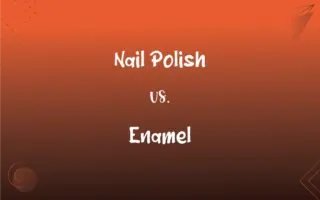Mosses vs. Ferns: What's the Difference?
Edited by Aimie Carlson || By Harlon Moss || Updated on October 16, 2023
Mosses are non-vascular, small, spore-producing plants, while ferns are vascular plants with larger, divided leaves and reproduce via spores.

Key Differences
Mosses belong to the bryophyte group, while ferns are part of the pteridophyte group. Mosses are considered more primitive, with ferns showing more advanced characteristics.
Mosses lack specialized tissues like xylem and phloem to transport water and nutrients, making them non-vascular. Ferns, on the other hand, have a well-defined vascular system, allowing them to grow larger.
When observing the lifecycle, mosses spend most of their time in the gametophyte stage, which is haploid. Ferns predominantly exist in the sporophyte stage, which is diploid and has a defined root, stem, and leaves.
Mosses typically grow in dense, green mats and can be found in a variety of habitats from forests to deserts. Ferns are more diverse in form, often recognized by their feather-like leaves called fronds.
Both mosses and ferns reproduce using spores, but they have distinct reproductive structures. Mosses produce spores in capsules, while ferns produce them on the undersides of their leaves in structures called sori.
ADVERTISEMENT
Comparison Chart
Classification
Bryophytes
Pteridophytes
Vascular System
Absent (Non-vascular)
Present
Predominant Stage
Gametophyte (haploid)
Sporophyte (diploid)
Growth Form
Low-growing, often mat-like
Upright with distinct leaves
Reproductive Structure
Capsules
Sori on the undersides of fronds
ADVERTISEMENT
Mosses and Ferns Definitions
Mosses
Plants that lack true roots, stems, and leaves.
Instead of roots, mosses have structures called rhizoids that anchor them to the substrate.
Ferns
Vascular plants with feather-like fronds.
The delicate fronds of ferns can often be seen adorning forest understories.
Mosses
Small, non-vascular plants found in damp places.
Mosses often carpet the forest floor, providing a soft cushion underfoot.
Ferns
Exist primarily in their sporophyte stage.
When you see a fern plant, you are observing the sporophyte phase.
Mosses
Plants that reproduce via spores rather than seeds.
In the right conditions, spores released by mosses can colonize new areas.
Ferns
Seedless plants that reproduce via spores.
On the underside of ferns, small patches called sori produce spores.
Mosses
Primarily exist in their gametophyte phase.
When you walk on mosses, you're mostly treading on the gametophyte stage of the plant.
Ferns
Ancient plants with a history spanning millions of years.
Fossilized ferns provide a glimpse into prehistoric plant life.
Mosses
Often serve as indicators of environmental conditions.
The presence of certain mosses can indicate the quality and acidity of the soil.
Ferns
Often grown as ornamental plants due to their aesthetic appeal.
Many gardeners cherish ferns for their beauty and versatility in landscaping.
Mosses
Any of various green, usually small, nonvascular plants of the division Bryophyta, having leaflike structures arranged around the stem and spores borne in a capsule.
Ferns
Any of numerous flowerless, seedless vascular plants that produce spores giving rise to free-living gametophytes and that often have dissected leaves.
Mosses
A patch or covering of such plants.
Ferns
Plural of fern
FAQs
Do both mosses and ferns require moisture for reproduction?
Yes, both require a film of water for the movement of sperm during reproduction.
Are mosses and ferns flowering plants?
No, both mosses and ferns are non-flowering plants that reproduce via spores.
Are ferns older than mosses in evolutionary terms?
No, mosses are considered more ancient than ferns in the evolutionary timeline.
Why don't we see mosses as tall as ferns?
Mosses lack the supportive vascular tissues that allow ferns to attain height.
Is it true that mosses always grow on the north side of trees?
Not always; mosses grow in shaded, moist areas, which can be on any side depending on local conditions.
What's the main difference in the life cycle of mosses and ferns?
Mosses are predominantly in the gametophyte stage, while ferns are mostly in the sporophyte stage.
How do mosses get nutrients without true roots?
Mosses absorb water and nutrients directly through their leaves.
Can ferns grow in direct sunlight?
Most ferns prefer shaded areas, but some can tolerate direct sunlight with adequate moisture.
Can ferns be grown indoors?
Yes, many fern varieties are popular as indoor plants.
Are moss gardens beneficial?
Yes, moss gardens can prevent soil erosion, retain moisture, and provide habitat for microorganisms.
Do ferns have flowers or fruits?
No, ferns reproduce using spores and don't produce flowers or fruits.
How do mosses attach to surfaces?
Mosses use structures called rhizoids to anchor themselves.
Can ferns grow in desert conditions like some mosses?
While some ferns are adapted to dry conditions, mosses are more commonly found in deserts.
Why are mosses generally shorter than ferns?
Mosses lack a vascular system, limiting their size, while ferns have vascular tissues allowing them to grow taller.
Why are mosses often found on rooftops and walls?
They can grow in areas with sufficient moisture and minimal competition.
Are there any edible ferns?
Yes, fiddlehead ferns are edible and are considered a delicacy in some cultures.
Can mosses purify the air?
Yes, like other plants, mosses can absorb pollutants and produce oxygen.
Do ferns grow from seeds?
No, ferns grow from spores, not seeds.
Are all ferns safe to touch?
While most ferns are safe, some can cause skin irritation.
Are there aquatic ferns?
Yes, some ferns like the water fern grow in aquatic environments.
About Author
Written by
Harlon MossHarlon is a seasoned quality moderator and accomplished content writer for Difference Wiki. An alumnus of the prestigious University of California, he earned his degree in Computer Science. Leveraging his academic background, Harlon brings a meticulous and informed perspective to his work, ensuring content accuracy and excellence.
Edited by
Aimie CarlsonAimie Carlson, holding a master's degree in English literature, is a fervent English language enthusiast. She lends her writing talents to Difference Wiki, a prominent website that specializes in comparisons, offering readers insightful analyses that both captivate and inform.






































































